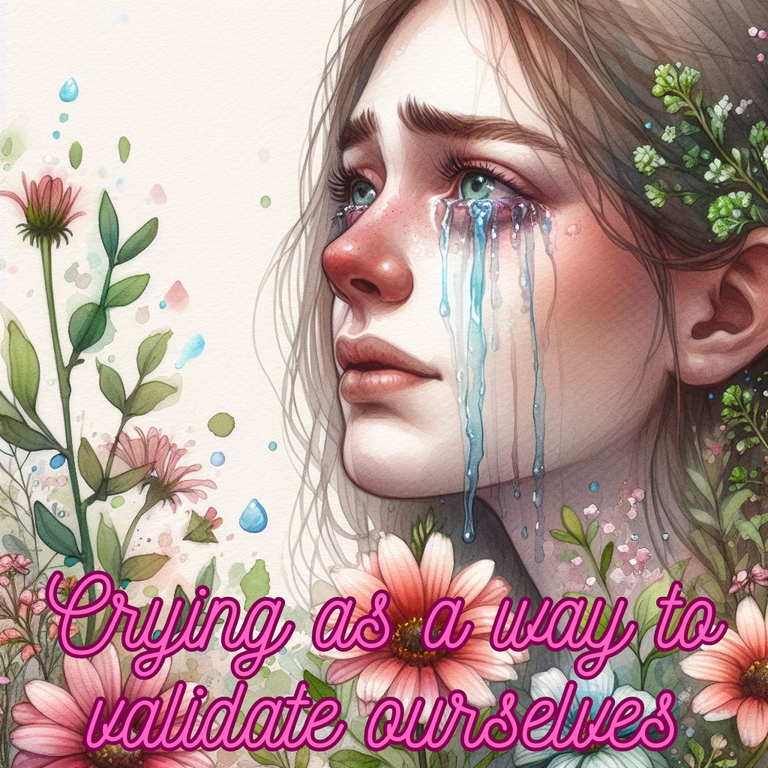
Llorar; el hecho de que nos broten lágrimas de los ojos, ha sido siempre sinónimo de tristeza o de que algo anda mal con quien llora. Por ende, nos preocupamos, incluso, nos asustamos y podemos o bien intentar mitigar el llanto, o bien evadir la situación «embarazosa». Sin embargo, el llanto no tiene que ser necesariamente malo o sinónimo de tristeza.
Por la cultura nos llega que, a nivel de representaciones, el llanto se produce cuando hay dolor, cuando hay tristeza, cuando hay abatimiento. Asumimos que el llanto, como si fuese un síntoma y nosotros médicos, hay que atacarlo e intentar anularlo, sin tener en cuenta irónicamente a la persona que llora. Normalmente existe la presunción de los estados alegres sobre los tristes, como si estar triste o sentir dolor fuese malo o patológico, algo así como distintivo de gente enferma o disfuncional.
«La vida tiene que ser toda feliz, la tristeza no es admisible, todo lo que refleje sufrimiento es negativo». Este es el pensamiento que prima en nuestros tiempos, pero si nos ponemos a pensar, el sufrimiento es intrínseco a la vida también. Quizás podamos pensar que no somos capaces de lidiar con el sufrimiento ajeno, o que de tan incómodo que nos resulta porque nos han enseñado que todo tiene que ser bonito y alegre (vaya ilusión esta), preferimos eliminarla a base de sentencias que más que dar apoyo o empatizar con quien llora, lo que logran es borrar a la propia persona de la ecuación. Pero también pasa que nosotros mismos no somos capaces de lidiar con nuestro propio sufrimiento, y precisamente esto se desprende de lo anterior, porque si crecimos aprendiendo a reprimir nuestros llantos para evitar la reprobación de nuestro entorno, pues en el momento en punta en el que como adultos queramos llorar por alguna contingencia de la vida, no nos lo permitiremos.
El llanto puede ser liberador, relajante, catártico. Además de la función orgánica que cumple para excretar desechos de nuestro cuerpo justo como el sudor o la orina, el llanto sirve tanto para manifestar un estado emocional negativo como positivo. Permitirnos llorar es una forma de acceder de una forma más genuina y personal a aquello que nos hace sufrir o alegrarnos porque, siendo objetivos, también se llora de felicidad, pero el sentido común no está preparado para esa conversación. Entonces, llorar puede ser una forma de conocer nuestros límites, aquello que nos mortifica o que nos conmociona, validar nuestros sentimientos y emociones al ser coherentes con lo que estamos experimentando en carne propia.
Es por eso que patologizar al llanto o darle un matiz negativo, tanto el nuestro como el ajeno, no es más que otro convencionalismo social que se ha asumido tácitamente, pero que como construcción social al fin, merece ser cuestionado. En ese sentido, llorar debiera ser más un comportamiento tan normalizado como reír y estar a su mismo nivel, porque también tenemos todo el derecho del mundo a sentirnos mal, o bien, porque al fin y al cabo también se llora de alegría.
Así que cuando veas a alguien llorar, no intentes que deje de hacerlo, al contrario, anímalo a que lo haga todo lo necesario. Así estarás validando su estado de ánimo y la persona se sentirá acompañada, comprendida, apoyada. De lo contrario, estarás negando que hay una persona con un estado de ánimo particular producto de una situación particular. Además, haciendo esto te estarás despojando del egoísmo característico de las personas que no saben lidiar con el sufrimiento ajeno.
English version

Crying; the fact that tears well up in our eyes has always been synonymous with sadness or that something is wrong with the person crying. Therefore, we worry, even panic, and may either try to mitigate the crying or avoid the "embarrassing" situation. However, crying is not necessarily bad or synonymous with sadness.
Through culture we learn that, at the level of representations, crying occurs when there is pain, when there is sadness, when there is despondency. We assume that crying, as if it were a symptom and we doctors, must attack it and try to annul it, without taking into account ironically the person who cries. There is usually a presumption of happy states over sad ones, as if being sad or feeling pain were bad or pathological, something like distinctive of sick or dysfunctional people.
"Life has to be all happy, sadness is not admissible, everything that reflects suffering is negative". This is the prevailing thought of our times, but if we think about it, suffering is intrinsic to life as well. Perhaps we may think that we are not capable of dealing with the suffering of others, or that we are so uncomfortable because we have been taught that everything has to be beautiful and happy (what an illusion this is), that we prefer to eliminate it with sentences that rather than giving support or empathizing with those who cry, what they achieve is to erase the person himself from the equation. But it also happens that we ourselves are not able to deal with our own suffering, and precisely this follows from the above, because if we grew up learning to repress our cries to avoid the reprobation of our environment, well, at the moment when as adults we want to cry for some contingency of life, we will not allow it.
Crying can be liberating, relaxing, cathartic. In addition to the organic function it fulfills to excrete wastes from our body just like sweat or urine, crying serves both to manifest a negative and a positive emotional state. Allowing ourselves to cry is a way to access in a more genuine and personal way to that which makes us suffer or rejoice because, being objective, we also cry for happiness, but common sense is not prepared for that conversation. Then, crying can be a way of knowing our limits, what mortifies or shocks us, validating our feelings and emotions by being coherent with what we are experiencing in our own flesh.
That is why pathologizing crying or giving it a negative nuance, both our own and that of others, is nothing more than another social conventionalism that has been tacitly assumed, but as a social construction, it deserves to be questioned. In this sense, crying should be as normalized behavior as laughing and be at the same level, because we also have every right in the world to feel bad, or good, because after all, we also cry for joy.
So when you see someone crying, don't try to stop them from crying, on the contrary, encourage them to cry as much as necessary. This way you will be validating their state of mind and the person will feel accompanied, understood and supported. Otherwise, you will be denying that there is a person with a particular state of mind resulting from a particular situation. In addition, by doing this you will be removing the selfishness characteristic of people who do not know how to deal with the suffering of others.

Créditos | Credits
Imágenes utilizadas | Images used
Todas las imágenes utilizadas son de mi propiedad y fueron generadas utilizando Copilot de Bing y editadas en Canva | All images used are my own property and were generated using Copilot from Bing and were edited using Canva.
Traducción | Translation
Te puede interesar | You may be interested in
¿Depresión de alto funcionamiento? | High-functioning depression? [ES/EN]
Sigamos hablando del autocuidado | Let's keep talking about self-care [ES/EN]
¿Las media naranjas ruedan? | Does half oranges roll? [ES/EN]
¿Conoces el «porno» de productividad? | Do you know about productivity "porn"? [ES/EN]
Sígueme en mis redes sociales | Follow me on my social media platforms
|X|
|LinkedIn|
There are so many reasons why we find crying negative. Emotions affect those around us as well as ourselves and I think that is another reason why we try to avoid crying in front of others. We don't want to make them unhappy as well.
That's what I said: people don't know how to deal with the suffering of others. And that is why crying should be normalized like laughing.
Thanks for reading and commenting.
El llanto es la expresión del alma en el cuerpo para drenar y liberarse. comparto contigo, que es sano, llorarr
Gracias 🤗
Excelente artículo hermano!! Muy correcta tú forma de validar el llanto como parte de nuestra existencia... hay momentos de catarsis y momentos de alegría, en ambos nos brotan las lágrimas... gracias!
Gracias a ti por leer y por además dejarme tu comentario, que al fin y al cabo son el alimento de quienes publicamos acá.
Que buena de abordaje del tema, para mí el llanto es una forma de drenar por eso le enseño a mi hijo que es humano natural y maravilloso expresarse de esa manera.
Maravilloso que le haya enseñado eso. Definitivamente será una persona con mejor bienestar emocional.